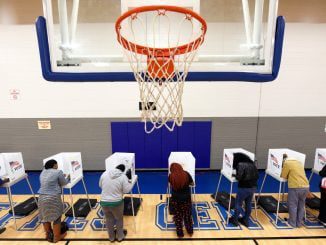
WASHINGTON, D.C. — The U.S. Postal Service’s famous motto — “Neither snow nor rain nor heat nor gloom of night stays these couriers” — is being tested like never before, by challenges that go well beyond the weather.
The coronavirus has devastated its finances. The Trump administration may attach big strings to bailouts.
The agency’s responsibilities, meanwhile, are mounting. A dramatic shift in many states push to vote by mail is intended to protect voters from spreading the virus at polling places. But it’s also making more work for post offices and contributing to delays in determining election winners.
Election results have been delayed this week in Kentucky and New York because both states were overwhelmed by huge increases in absentee by-mail ballots.
“What we don’t need is more chaos in the chaos,” said Wendy Fields, executive director of the voting rights advocacy group The Democracy Initiative.
President Donald Trump opposes universal voting by mail, asserting it will trigger fraud.
The president has also called the Postal Service “a joke” and says package shipping rates should be at least four times higher for heavy users such as Amazon. But shipping packages is a main revenue generator, and some critics say Trump is merely looking to punish Amazon founder Jeff Bezos in retaliation for unflattering coverage in The Washington Post, which the billionaire owns.
Trump has acknowledged larger political calculations are at work, tweeting that expanding vote by mail will “LEAD TO THE END OF OUR GREAT REPUBLICAN PARTY.” His Democratic rival, Joe Biden, has suggested that Trump’s opposition to absentee voting and criticism of the Postal Service may help the incumbent “steal” the election.
The Postal Service predates the United States. It was created by the Second Continental Congress in July 1775, and Benjamin Franklin was the first postmaster general.
Unlike its private competitors, the Postal Service cannot refuse to make costly deliveries to especially hard-to-reach addresses. Still, much of its budgetary concerns stem from a 2006 law requiring the agency to fully fund retiree health benefits for the next 75 years.
It normally operates without taxpayer funds. During the pandemic, however, it lost $4.5 billion in the 2020 budget year’s second quarter. Congress approved a $10 billion line of credit for the agency as part of an economic rescue package in March. Since then, though, the Postal Service and the Treasury Department have had discussions about requirements to extend those loans.
Neither side will say publicly what’s being negotiated, but Trump has made his feelings clear. A 2018 Treasury task force also recommended the Postal Service increase package rates and cut labor costs. A second coronavirus aid package passed in May by the Democratic-controlled House includes $25 billion in direct aid for the Postal Service, but the GOP-majority Senate hasn’t approved its own version.
More than 3,420 of the Postal Service’s 630,00-plus employees have tested positive for COVID-19, and some have died. While package deliveries have increased as Americans stay home, mail volumes plummeted — as much as 30%, according to the American Postal Workers Union.
In April, then-Postmaster General Megan Brennan said the agency could be out of money by Sept. 30. Louis DeJoy, a North Carolina businessman who has over 30 years in logistics, recently succeeded Brennan.
Postal Service spokesperson David Partenheimer said more recent trends “indicate that our 2020 financial performance will be better than our early scenarios predicted,” though he said much remains uncertain.
“Our current financial condition is not going to impact our ability to deliver election and political mail this year,” Partenheimer said.
But Condos, who was president of the National Association of Secretaries of State from July 2018 to July 2019, fears keeping such a promise could force the Postal Service to cut back on routine services, which may see voting materials prioritized over regular mail. The pressure is also on because absentee ballots for overseas military members are sent 45 days before Election Day — or Sept. 18, which is less than three months away.
“This whole idea that we have until November to decide, we really don’t,” Condos said.
The Postal Service consistently ranks as the nation’s favorite federal agency. Pew Research Center polling in March found that 91% of Americans said they had a favorable view of it.



